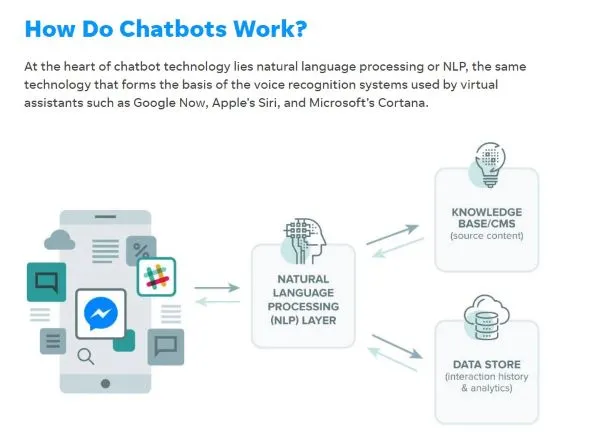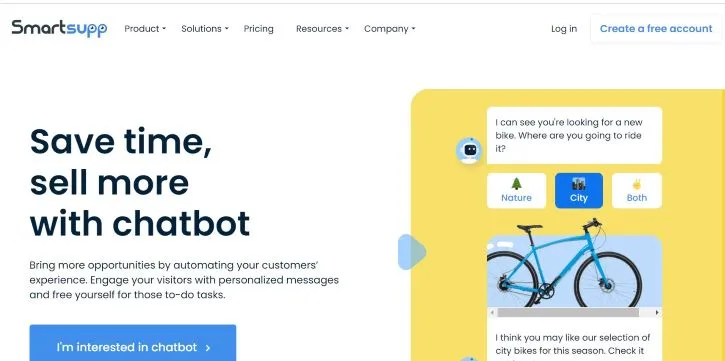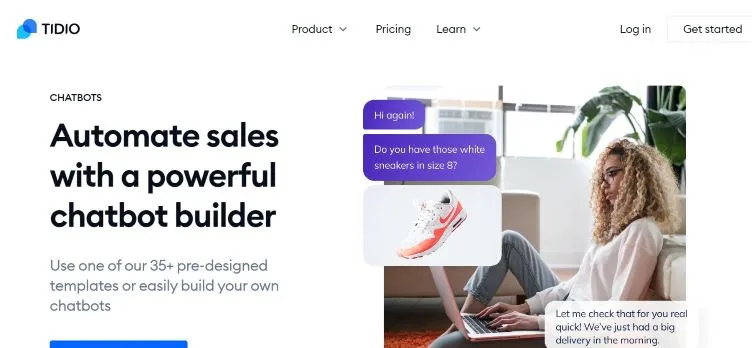As customers, we increasingly enjoy the benefits of artificial intelligence, voice assistants (e.g., Google Assistant, Amazon Alexa), and conversational user interfaces without being aware of this.
Lately, we've dealt with voicebots and chatbots, which are linked to the current topic. You can read about them here: What is a Voicebot? Voicebot design and What is a Chatbot? Chatbot design.
Today, we'll address a more general issue: What is a conversational user interface (CUI), and how is it designed?
Chatbots and voicebots have become popular for many reasons.
Looking at the course of real-time interactions, their increasing effectiveness, and increasingly perfect natural language processing, the presence of an intelligent assistant in applications and increasingly smart homes is not surprising.
Virtual assistants send messages to users, perform specific tasks, and answer user questions in a sensible, relevant, and helpful manner.
Conversational interfaces facilitate communication and get better and better at speech simulation. They're increasingly taking over customer service and responding in a natural language, sounding more and more human.
The revolution in communication, communication automation, and AI-based customer service wouldn't be possible without conversational user interfaces that, like any other type of interface, must be designed with user experience in mind.
Hence, today's questions will be as follows:
What is a conversational interface? How does it work? What are the types of conversational interfaces?
What are the most common applications and use cases of conversational interfaces, and what are the benefits of using them for an organization?
You will find the answers in this article!
What is a conversational user interface?
As usual, let us define the term first.
Conversational user interfaces (CUI) are the interfaces that allow user-software interactions through text or voice.
The purpose is to imitate real-world and natural communication behavior and to make the dialog as real-life and satisfactory as possible. In short, a conversational UI converts human language into computer language, allowing users to communicate with software.
For quite some time, conversational user interfaces have been replacing graphical user interfaces or command-line interfaces, which were unpopular among users and had a bad reputation.
Modern conversational interfaces enable human-software dialog using natural language.
A significant advantage of conversational interfaces and virtual assistants is the possibility of integrating them into digital products.

They're also highly attractive to use. Their use doesn't require prior preparation, knowledge, or training, significantly increasing their accessibility and usability.
Natural language understanding and natural language processing
The impression of natural conversation can be achieved, among other things, through natural language understanding (NLU) technology, which enables voice recognition and conversational pattern analysis and interpretation.
AI-based natural language processing, natural language understanding, and human speech recognition, which have advanced rapidly over the past few years, have enabled many industries to communicate with users via conversational user interfaces.
They allowed them to support many processes in a much more efficient way.
How did these technologies help?
Firstly, it has been recognized that a significant portion of the questions and answers in the customer and user service processes can be automated. Secondly, it has been found that it can be handled while maintaining a constantly improved high quality.
Thirdly, conversational interfaces handling queries and conversations with artificial intelligence also have the advantage of enabling you to get a fast and relevant answer quickly and successfully.
Fourthly, in many cases, the interaction between a human and a machine, software, and artificial intelligence doesn't differ significantly from the conversation, dialog, or information exchange between humans.
Fifthly, conversations are becoming more flexible and natural, far from the early days of this technology, when they primarily consisted of finding syntax-specific commands or icons and buttons in the graphical user interface (GUI).
The times when the conversation meant the need to enter commands instead of asking questions are becoming a thing of the past.
Modern conversational user interfaces are much more:
- Versatile
- Flexible
- Mimetic, or "human": they can mimic typical communication behavior in specific situations or contexts
- Adaptive: they gain experience, learn, and correct their reactions with each new interaction and conversation
- Effective
- Usable.
To sum up, a conversational interface:
- Enables the user to express themself in an individual manner
- Can be used in web and mobile applications
- Can in equal measure (interchangeably or simultaneously) use written and spoken language
- Enables you to maintain and use the principles of human-to-human conversation
- Allows text-to-speech and speech-to-text conversion
- Takes two forms: voice assistant and chatbot (text assistant).
How do conversational user interfaces work?
The dynamic development of the technologies employed in CUI promotes their popularization.
Organizations are increasingly willing and convinced to utilize bots to relieve, improve, and streamline the handling of simple questions and issues.

With artificial intelligence and machine learning, conversational interfaces are improving. Through the use of AI, they can interpret human speech more accurately.
Conversational UI can:
- Understand increasingly complex questions expressed in a way far from command and instruction formulas.
- Answer increasingly complex questions.
- Generate questions independently, enabling them to clarify the range of subjects, determine the expectations, and probe the needs.
- Take the initiative, suggest, recommend, diagnose, give opinions, prompt, explain, express curiosity, and show interest.
Conversational interfaces are no longer:
- Crude
- Rigid
- Annoying
- Daunting
- Primitive
- Limited in terms of use
- Passive.
Conversational user interfaces are mainly based on two technologies:
- Natural language processing (NLP)
- Natural language understanding (NLU).
NLP and NLU employ the knowledge of linguistics, IT, cognitive science, artificial intelligence, and others.
Conversational interfaces are mainly created from several key components, including:
- Component for voice recognition and speech-to-text conversion
- NLU/NLP
- Dictionaries and libraries of language samples
- Contexts
- Business logic.
What are the types of conversational user interfaces?
The main interface division criterion is the manner of interaction with the software.

Conversational interfaces can be divided into:
- Chatbots
- Voicebots
In the case of chatbots, the conversation, dialog, and interaction are carried out using the written word entered in the chat window via keyboard.
Interactions with voicebots are performed using spoken words and a microphone.
So far, paradoxically, chatbots appear more natural than voicebots because users are used to chatting. With the popularization of mobile phones, SMS, social networks, and instant messengers, text communication has become widespread and natural.
Voicebots, or voice user interfaces (VUI), communicate with the users through sound.
Although increasingly common, VUIs are still not as popular as chatbots. Due to the following barriers:
- Economic: they're still quite expensive.
- Psychological: people haven't grown accustomed to voice communication with software.
The most common applications and use cases of conversational user interfaces
Text and voice assistants are gaining popularity. It's not a great exaggeration or a thing of the future that we have entered the era of conversational interfaces and customer and user service automation.
Obviously, not in all industries, conversational UIs are greeted with great understanding and interest.
Currently, most such technologies, solutions, and functionalities can be found in industries where efficient service plays a unique role in the sales and after-sales processes.
Conversational user interfaces are the most popular in the following industries:
- E-Commerce
- Healthcare
- Travel
- Entertainment
- Transport
- Education
- Catering
- Hospitality
- Finances, finance services, and banking
A significant advantage of conversational interfaces for customers and business owners is the ability to perform different roles.

Also, the functions they perform, external, front-line, and internal, related to data aggregation, analysis, and interpretation, are beneficial and will win them supporters.
You need to remember that assistants can be helpful tools for supporting:
- Service processes
- Sales processes and systems, sales funnel
- Organization and logistics processes
- Communication and promotion processes
- Information processes
- Billing, ordering, and stock monitoring processes
- Modeling, mapping, and planning processes
- Daily user activities (e.g., Internet of Things or IoT)
What are the benefits of using conversational user interfaces for an organization?
In the era of conversational interfaces, we benefit most from comfort and speed.
Text and voice assistants have the advantage over full-time assistants that the AI and the system behind them:
- Are not limited by labor law
- Are not limited by physical and mental capacity; they can be overloaded without the risk of professional burnout
- Are available without time constraints and do not keep the customers waiting for longer than fractions of seconds
- Can serve more customers in a given unit of time
- Can reach critical information faster and combine pieces of information more easily and more efficiently
- Are able to anticipate, forecast, and analyze
- Are proactive: offer suitable suggestions based on contextual information.
Conversational interfaces provide even more in terms of communication and usability related to user experience in the language aspect. Their main goal is to increase customer satisfaction and provide convenient customer interactions.

Communication through conversational user interfaces is:
- Subject to a lower interaction cost
- Much more efficient, natural, and convenient for the user because modern artificial intelligence on which the interfaces are based doesn't set any boundary conditions (e.g., the knowledge of commands)
- Consistent with daily methods and patterns of social interactions
- Faster when writing and even faster when providing information by voice
- More and more integrated with daily activities, behavior, routines, tasks, and goals. And in the era of IoT, it will be increasingly natural
- Customized with the use of historical data.
In a nutshell, conversational interfaces concern the following issues:
- Business
- Economic
- Usability
- Civilization
- Market
- Strategic
- Technological (AI handles input data and formulates correct answers)
- Branding
Raluca Budiu, the Director of Research at Nielsen Norman Group, in her article "The User Experience of Customer-Service Chat: 20 Guidelines," mentions three main advantages of modern chatbots and voicebots.
Three main advantages of modern chatbots and voicebots:
- The emotional benefit of greater ease of interactions with an automatic assistant than with a human, especially in the case of products and services that can be embarrassing.
- Trace of conversation in the form of a recording that can be the basis of further actions.
- Capability of smooth multi-tasking operation.
In addition, in her other article, "The User Experience of Chatbots," Budiu refers to the users' attitudes toward conversational UIs, which Nielsen Norman Group researchers discovered during their research.
Generally, a conversational UI evokes reactions from neutral to positive, but simultaneously, it's considered less helpful than humans.
Then again, according to Budiu, the most important advantage offered by this technology to the users surveyed by NN Group was the speed. A conversation with a human typically involves a long waiting time.
Such general conclusions shouldn't be extrapolated and regarded as binding for every industry, business, segment, target, or country. The research was conducted in the US market, and even there, it is moderately binding.
The general memento phrased by the NN Group researcher is simple.
Some, particularly simple, typical, and repetitive user questions, needs, and goals, can be effectively handled in an automated manner.
By handling them effectively, a company will benefit from productivity, efficiency, cost-effectiveness, image, and user experience improvements.
Success depends on a perfect chatbot or voicebot. If it is too primitive, people will lose confidence in a company and feel ignored and unappreciated. They won't be able to achieve their goals and perform tasks. They will waste time, patience, and trust.
Conversational UI Design: What can AI do?
We should start with a remark that may seem as obvious as it's easy to ignore regarding its importance and implications.
Namely, the way of interacting with conversational user interfaces differs entirely from the mode of interaction with graphical user interfaces. GUIs mainly rely on visual and textual clues to guide the user; meanwhile, users of conversational UIs need to explore the capabilities of the AI on their own.

This means designing a consistent conversational user experience with software is quite complex.
You should keep in mind the following issues:
- Technology capabilities and limitations
- User awareness as regards the conversational user interface capabilities and limitations
- Specific nature of software interactions
- Obtainable level of accuracy and concreteness of query understanding
- Obtainable degree of understanding of user intentions by the software
- Perfected handling of queries that are implicit, vague, and incorrect in terms of language and content
- Need to define use cases
The development of conversational interfaces also involves paying particular attention to the following:
- In typical use cases, especially for designing voicebots, a public formulation of voice queries can be uncomfortable, and the audial conditions of the environment can affect the quality of query recognition and interpretation.
- Chatbot or voicebot purpose: both from the user's and the business owner's side.
- Relevance of CUI in terms of typical user problems, needs, and expectations.
- Relevance of CUI in terms of the nature of a given channel: desktop vs. mobile.
- Issue of task handover and redirecting the conversation to a human agent when the level of complexity of the user issue is beyond the bot's capabilities (human handover).
Further issues that absolutely must be kept in mind are:
- Conversation flow and substance
- Message tone
- Bot image or personality, or more generally, a bot persona.
When designing a bot persona and giving it specific features, remember the remark Eric Hal Schwartz made in his article "People Prefer Virtual Assistants That Seem Happy: Study."
According to the study cited by Schwartz, the bots that seemed happy to the users were rated better and more useful. It turned out that the users tend to reflect the mood, which affects the course and result of the interaction.
A conversational user interface that is attractive in the user's eyes is an interface that is based on the answers to the following questions:
- What will the user want to do with the software?
- What goals will the user want to achieve?
- What will be the most effective way to solve the user's problem?
- What system operations most effectively minimize the user's efforts to reach the goal and communicate with the system?
Conversational user interface. Summary
- In the era of conversational user interfaces, the users, most of all, benefit from comfort and speed.
- As customers and users, we aren't always aware that we use conversational interfaces.
- Conversational user interfaces facilitate communication and are increasingly better at simulating a natural human-to-human conversation.
- Conversational UIs are increasingly taking over customer service.
- Conversational interfaces' answers are becoming increasingly natural. Therefore, conversational user interface development should focus on obtaining the effect of natural dialog.
- Conversational user interfaces enable user-software interactions using text or voice.
- The CUI designers should imitate the natural communication behavior and make the dialog as real-life and satisfactory as possible.
- Modern conversational interfaces enable human-software dialog using natural language.
- Using CUI doesn't require prior preparation, knowledge, or training.
- Conversational user interfaces are more and more accessible and usable.
- The impression of natural conversation can be obtained through natural language understanding technology and machine learning, among others.
- Modern conversational UIs are much more versatile, flexible, mimetic, and adaptive.
- Conversational interfaces can be used in web and mobile applications.
- The dynamic development of the technologies employed in CUI promotes their popularization.
- Organizations are increasingly willing and convinced to utilize bots to relieve, improve, and streamline the handling of simple questions and issues.
- Conversational user interfaces are no longer crude, rigid, annoying, daunting, and of very limited use. The development of conversational UI currently goes way beyond writing scenarios and dialog scripts.
- A significant advantage of a conversational interface for customers and business owners is the ability to perform different roles.
- Communication through a conversational interface is subject to a lower interaction cost, is much more efficient, convenient for the user, and consistent with daily methods and patterns of social interactions.
- Conversational user interfaces concern business, economic, civilization, marketing, strategic, and branding issues.
- Generally, a conversational UI evokes reactions from neutral to positive, but it's also considered less helpful than humans. Therefore, the creation of a conversational user interface must be sensitive to these issues.
- According to the users surveyed by NN Group, the major advantage of this technology is speed.
- The way of interaction with conversational user interfaces is completely different from the mode of interaction with graphical user interfaces.
- Designing a consistent conversational experience and developing conversational user interfaces are complex tasks.






